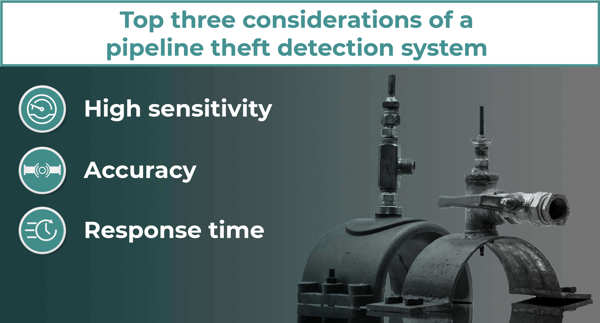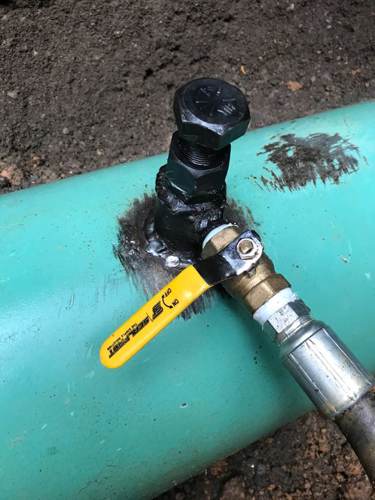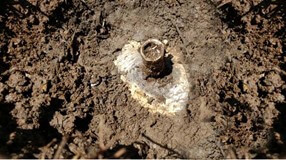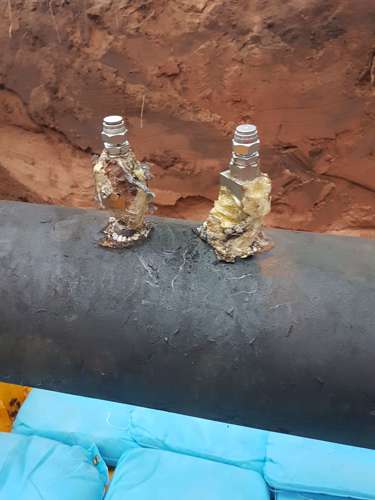Why are theft detection systems crucial?
Pipeline theft continues to be a serious global issue for operators. The consequences of undetected illegal tapping points can be catastrophic, in terms of the damage to pipeline infrastructure, the likelihood of a leak and the drain on company profits.
Oil theft is the most notorious, with gas also being popular among pipeline product thieves. The methods being used are continually evolving and becoming ever more sophisticated, which is why a reliable theft detection system is so important.
In this article we’ll discuss the top three requirements of a pipeline theft detection system, including:
- High sensitivity - Detecting every small product withdrawal
- Accuracy - Locating tapping points as accurately as possible
- Response time - Detecting product withdrawals as quickly as possible

1. Sensitivity
This is a vital consideration for theft detection systems, particularly if pipeline thieves are subtle in their approach. Sensitivity is all about being able to detect even the smallest of product withdrawals from the pipeline.

Often thieves deploy the following strategies so that their activities remain unnoticed:
- Opening and closing theft valves very slowly to generate only a small pressure change over longer periods
- Maintaining the theft rate below flowmeter accuracy level
- Carrying out theft activity at night
- Stealing small volumes each time but often
- Using multiple locations along the pipeline
- Leaving tapping points untouched for lengthy periods of time (years in some cases)
- Doubling tapping points opening at slightly different times
The negative pressure wave (NPW) method used by Atmos Wave provides a high level of sensitivity using the 60 Hz sample rate. This means that it can detect the theft event even when thieves open or close valves slowly to avoid arousing suspicions. Data is acquired and analyzed at a frequency that is much higher than the typical five-second supervisory control and data acquisition (SCADA) rate. It is a specialized method for detecting both thefts and leaks. The data acquired is stored locally in the Atmos Wave Acquisition System (AWAS), ensuring that no theft events (or leaks) are missed if there is a communication failure.
The fact that the theft rate can be lower than 0.1% of nominal pipeline flowrate poses additional challenges for pipeline operators since it means the minimum leak size needs to be lowered for the theft to be detected. However, this can result in an increase in false alarms by the theft detection system because the identified flow and pressure changes are mostly below the instrument repeatability and process noise level.

Offline services such as Atmos Theft Net can help to counteract this, using expert analysis to interpret the data collected by fixed and portable hardware solutions. Combining technology such as Atmos Wave and this kind of service avoids unnecessary false alarms. The data is filtered to present only relevant information, and the locations of illegal tapping points are estimated accurately.
On pipelines where there is limited instrumentation, hardware can be used in conjunction with software solutions like Atmos Wave. Atmos Eclipse for example is a non-intrusive flow, pressure and temperature measurement instrumentation that has cellular, radio and standard RS485 and TCP/IP communications. This helps to improve the sensitivity of theft detection and provide real-time data anywhere it’s needed.
2. Accuracy
The next vital consideration is accurately locating the illegal tapping points. Pipelines can be thousands of miles long, in remote and urbanized areas. It’s not practical, cost effective or safe for engineers to search the entire length of the pipeline for tapping points (or leaks).
NPW theft detection can accurately pinpoint the location of tapping points. Solutions like Atmos Wave can locate the tapping points within meters. The location accuracy is improved through the higher data sample rates.
In addition to Atmos Wave, adding the AWAS units to a system like Atmos Pipe enables fast scanning, improving the leak location to be as accurate as 100 meters with correct conditions. Fast scanning can also be added by connecting to SCADA systems that support historical reads using OPC UA, allowing pressure data reading at a higher rate (50ms to 100ms) on request.
Since theft activity is usually below the flow meter accuracy and repeatability level, it is difficult for the statistical volume balance method to detect small thefts under running conditions unless false alarms are accepted. But Atmos Pipe does include an additional theft module for detecting thefts during shut-in conditions to maintain reliability for leak and theft detection.

Solutions like Atmos Wave Flow use elements from both the NPW and volume balance methods. This multi-method approach helps to reduce uncertainty and improve the performance of the system for theft detection. The high location accuracy typically means you can pinpoint a theft event below 0.25% of monitored section length providing there are correctly placed sensors.
For remote areas, hardware that detects theft can help to identify illegal tapping points and locate them to within meters. Atmos Odin is an easy-to-use data acquisition unit designed for areas without power or communications.
The internal GPS acquires an accurate location and time lock while Atmos Odin is transported to the installation site, the device will then continually log the GPS data with measurements from its internal pressure sensor. Data collected by Atmos Odin is then analyzed by Atmos Theft Net engineers to effectively detect and locate theft sites to a high accuracy. Recently, a tapping point was quickly and easily located in Africa using Atmos Odin, with the location estimate being enough for the customer to uncover the tapping point quickly.
3. Response time
The final key consideration of a theft detection system is response time. To effectively counteract theft activity, it is crucial that the system can alert the pipeline operators as quickly as possible. Response time is particularly important for where the ‘grab and go’ approach is used by the thieves, since this is more likely to cause a leak or even a rupture in the pipeline.
Solutions that use both volume balance and NPW methods like Atmos Wave Flow have an extremely fast theft detection time. Recently, the software was able to quickly detect and alert a customer of five separate theft events on a pipeline in Europe. The thieves were seemingly getting bolder each time they took product from the pipeline, stealing three nights in a row on one occasion. Using fine tuning of Atmos Wave Flow and a supporting piece of hardware, Atmos Eclipse, the customer was able to locate the illegal tapping point to around 40 meters away from the calculated leak location. The operation was very sophisticated, with the thieves attaching a portable 90 degree pipe bend and a 10 meter hose to connect up to six IBCs in a small truck, a sophisticated operation.
Multi-method theft detection systems are vital to counteract tactic innovation
Ultimately, a good theft detection system will be effective in all three of the considerations we’ve discussed. Atmos Wave Flow uses a multi-method approach in NPW and volume balance to perform well in all areas and be reliable while doing so with a low false alarm rate. Particularly for where gas and oil thieves are running a calculated and sophisticated operation where they wish to remain hidden, high sensitivity is vital for stopping the activity in its tracks.
Another aspect to consider when selecting a theft detection system is that tactics the thieves use are always being innovated. This means a theft detection system also needs to be futureproof to help counteract this. Instrumentation like Atmos Eclipse and Atmos Odin can be used in conjunction with leak detection software to improve reliability and detect theft even in remote areas. This can be particularly useful where instrumentation, power and communication are limited and can significantly save on the cost to monitor the pipeline, providing a way to futureproof the pipeline.
The addition of the algorithms and automated learning to compensate for variations in Atmos Wave Flow means that corrections are made for any measurement errors such as meter drift, therefore increasing the reliability of the solution. It is a field proven theft and leak detection system that pipeline operators can trust.
